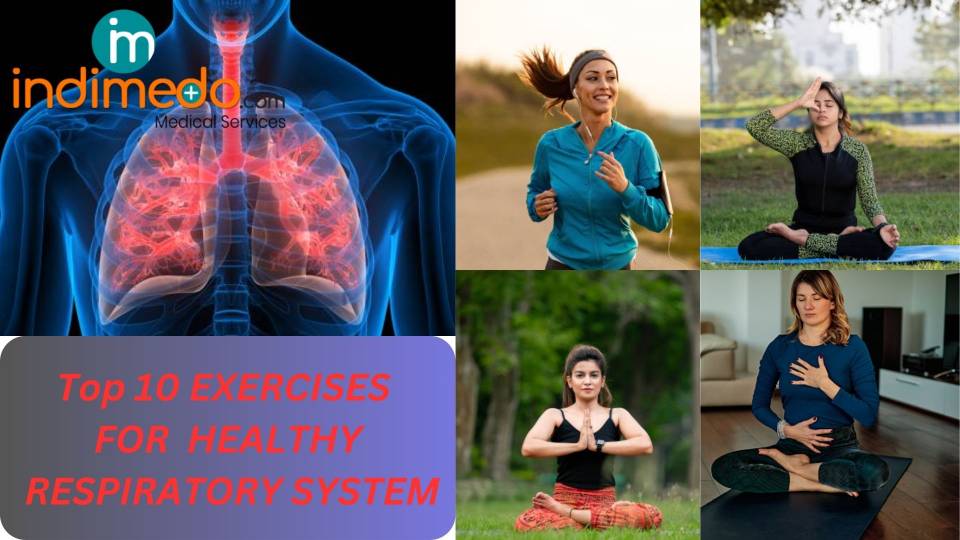Top 10 Exercises for a Healthy Respiratory System

Our lungs are a vital organ responsible for the exchange of oxygen and carbon dioxide in our bodies. A healthy respiratory system is essential for overall health and well-being. However, with the rise in air pollution and respiratory diseases, maintaining healthy lungs has become more important than ever. One of the most effective ways to maintain a healthy respiratory system is through regular exercise. In this blog post, we will share with you the top 10 exercises for a healthy respiratory system. Whether you're an athlete or a beginner, these exercises are easy to do and will leave you feeling great. So, let's get started!
The respiratory system plays a vital role in our body's functioning, as it is responsible for the exchange of oxygen and carbon dioxide. Maintaining a healthy respiratory system is essential for overall health and well-being. Regular exercise can help improve lung function, increase oxygen flow to the body, and reduce stress. Here are the top 10 exercises for a healthy respiratory system:
Diaphragmatic Breathing:
Diaphragmatic Breathing, also known as belly breathing, is a technique that involves breathing deeply into your diaphragm. This exercise helps increase lung capacity and improve overall respiratory function. To perform diaphragmatic breathing, lie on your back with your knees bent and your feet flat on the floor. Place your hands on your stomach and inhale deeply, feeling your stomach rise as you breathe in. Exhale slowly, feeling your stomach fall as you breathe out. Repeat for several minutes.
Deep Breathing:
Deep Breathing is a simple exercise that involves taking slow, deep breaths. This exercise helps increase oxygen flow to the body, which can reduce stress and improve overall lung health. To perform deep breathing, sit or stand with your back straight and your hands on your stomach. Inhale deeply through your nose, feeling your stomach expand as you breathe in. Exhale slowly through your mouth, feeling your stomach fall as you breathe out. Repeat for several minutes.
Pursed Lip Breathing:
Pursed Lip Breathing involves breathing in through your nose and exhaling through pursed lips. This exercise helps regulate breathing and can be particularly beneficial for people with lung conditions such as COPD. To perform pursed lip breathing, inhale deeply through your nose and exhale slowly through pursed lips, as if you were blowing out a candle. Repeat for several minutes.
Rib Stretch:
Rib Stretches involve expanding your rib cage while taking deep breaths. This exercise helps increase lung capacity and can be particularly beneficial for athletes. To Rib Stretches, stand with your arms extended out to the side. Inhale deeply and raise your arms above your head, expanding your rib cage. Exhale slowly and lower your arms to your sides. Repeat for several minutes.
Yoga Breathing Exercises:
Yoga Breathing Exercises, also known as pranayama, involve various breathing techniques that can help improve lung function, reduce stress, and increase oxygen flow to the body. Some examples of Yoga Breathing Exercises include Kapalabhati (Skull Shining Breath), Nadi Shodhana (Alternate Nostril Breathing), and Ujjayi (Victorious Breath).
Aerobic Exercise:
Aerobic Exercises such as running, cycling, or dancing can help improve lung function and increase overall fitness. These exercises are particularly beneficial for people with lung conditions such as asthma. Aerobic Exercise helps increase oxygen flow to the body and improve lung health.
Swimming:
Swimming is an excellent exercise for improving lung function and overall fitness. The resistance of the water provides a great workout for the lungs and can help increase lung capacity. Swimming is also a low-impact exercise that is gentle on the joints.
Walking:
Walking is a simple yet effective exercise that can help improve lung function and overall fitness. Regular Walking can help increase oxygen flow to the body and improve lung health. Walking is also a low-impact exercise that is easy to incorporate into your daily routine.
Jumping Rope:
Jumping rope is a high-intensity exercise that can help increase lung capacity and overall fitness. This exercise is particularly beneficial for athletes and can help improve endurance. To perform Jumping rope, start by jumping with both feet together, then progress to alternate foot jumps.
Benefits of Healthy Respiratory System
Maintaining a Healthy Respiratory System is crucial for overall health and wellness. Regular exercises can promote respiratory fitness, improve lung capacity, and strengthen respiratory muscles. In this article, we will discuss some of the key benefits of engaging in exercises for a healthy respiratory system.
-
Improved Lung Function: Regular exercises can enhance lung function by increasing the capacity and efficiency of the lungs. This can result in improved oxygen delivery to the body's tissues and organs, promoting overall health and vitality.
-
Increased Respiratory Muscle Strength: Exercises such as Diaphragmatic breathing and pursed lip breathing can strengthen the respiratory muscles, including the Diaphragm, intercostal muscles, and accessory muscles of respiration. This can improve respiratory efficiency and reduce the risk of respiratory muscle fatigue.
-
Enhanced Endurance: Engaging in regular aerobic exercise, such as brisk walking, running, or cycling, can improve cardiovascular fitness and endurance. This can reduce shortness of breath during physical activity and improve overall stamina.
-
Reduced Risk of Respiratory Infections: Regular exercise can enhance the immune system's function, reducing the risk of respiratory infections such as colds, flu, and pneumonia.
-
Improved Quality of Life: Engaging in exercises for a healthy respiratory system can improve overall quality of life, reducing symptoms of respiratory conditions such as asthma, chronic obstructive pulmonary disease (COPD), and bronchitis. It can also promote a sense of well-being and reduce anxiety and stress.
Conclusion
In conclusion, incorporating exercises for a healthy respiratory system into your daily routine can have numerous benefits for your overall health and wellness. By improving lung function, increasing respiratory muscle strength, enhancing endurance, reducing the risk of respiratory infections, and improving quality of life, regular exercises can help you breathe easier and live better.





 Login with Facebook
Login with Facebook
 Login with Google
Login with Google